name: title class: title, middle ## ML and DS to fight the climate emergency ### Visualising the effects of climate change, material discovery and downscaling Alex Hernández-García (he/il/él) .turquoise[Women in Machine Learning & Data Science · Yaoundé · July 24th 2021] .center[ <a href="https://mila.quebec/"><img src="../assets/images/slides/logos/mila-beige.png" alt="Mila" style="height: 6em"></a> <a href="http://wimlds.org/"><img src="../assets/images/slides/logos/wimlds-logo-only.png" alt="WiMLDS" style="height: 6em"></a> ] .footer[[alexhernandezgarcia.github.io](https://alexhernandezgarcia.github.io/) | [alex.hernandez-garcia@mila.quebec](mailto:alex.hernandez-garcia@mila.quebec) | [@alexhdezgcia](https://twitter.com/alexhdezgcia)] [](https://twitter.com/alexhdezgcia) --- ## About me -- * .highlight1[Bachelor's]: Image and Sound Engineering, University Carlos III of Madrid, Spain (2013) -- * .highlight1[Master's]: Machine Learning and Computer Vision, University Carlos III of Madrid, Spain (2015) -- * .highlight1[PhD]: Institute of Cognitive Science, Universität Osnabrück, Germany, with Prof. Peter König (2016–2020) * Based in Berlin * Marie Skłodowska Curie ITN “NextGenVis” (_Next generation of European visual neuroscientists_) * Intern at University of Cambridge (UK) and Spinoza Centre for Neuroimaging in Amsterdam (NL) * Thesis topics: Brain-inspired DL, visual perception and visual computational neuroscience -- * .highlight1[Postdoc]: Mila (Québec AI Institute in Montréal) with Prof. Prof. Yoshua Bengio (2021–_present_) --- ## When I am not training models or reading papers... ~~...I am reviewing papers, trying to empty my email inbox, having meetings...~~ --- count: false ## When I am not training models or reading papers... ~~...I am reviewing papers, trying to empty my email inbox, having meetings...~~ .center[] .footnote[[BrokenJugRamblers.bandcamp.com](https://brokenjugramblers.bandcamp.com/)] --- count: false ## When I am not training models or reading papers... ~~...I am reviewing papers, trying to empty my email inbox, having meetings...~~ .center[] --- count: false ## When I am not training models or reading papers... ~~...I am reviewing papers, trying to empty my email inbox, having meetings...~~ .center[] .footnote[[LumeDeBiqueira.es](https://www.lumedebiqueira.es/en/)] --- name: title class: title, middle ## ML and DS to fight the climate emergency ### Visualising the effects of climate change, material discovery and downscaling .alpha0[.left[ <br> ### .left[Outline] * [Visualising the effects of climate change](#vicc) * [Accelerating material discovery](#materialdiscovery) * [Downscaling Global Climate Models](#downscaling) ]] ??? So, after this brief ice-breaker, I can go back to the topic of my talk today, which is to present a few of the projects I am involved in at Mila, about finding ways of using machine learning, data science or more generally artificial intelligence to fight the current climate emergency. [NEXT SLIDE] --- name: title class: title, middle count: false ## ML and DS to fight the climate emergency ### .highlight1[Visualising the effects of climate change], material discovery and downscaling <br> ### .left[Outline] .left[ * [.highlight1[Visualising the effects of climate change]](#vicc) .alpha0[* [Accelerating material discovery](#materialdiscovery)]* .alpha0[* [Downscaling Global Climate Models](#downscaling)]* ] --- name: title class: title, middle count: false ## ML and DS to fight the climate emergency ### Visualising the effects of climate change, .highlight1[material discovery] and downscaling <br> ### .left[Outline] .left[ * [Visualising the effects of climate change](#vicc) * [.highlight1[Accelerating material discovery]](#materialdiscovery) .alpha0[* [Downscaling Global Climate Models](#downscaling)*] ] --- name: title class: title, middle count: false ## ML and DS to fight the climate emergency ### Visualising the effects of climate change, material discovery and .highlight1[downscaling] <br> ### .left[Outline] .left[ * [Visualising the effects of climate change](#vicc) * [Accelerating material discovery](#materialdiscovery) * [.highlight1[Downscaling Global Climate Models]](#downscaling) ] --- name: vicc ## Visualising the effects of climate change    --- ## Visualising the effects of climate change ### Motivation -- There is a mismatch between the magnitude of the climate crisis and the general public's concern about it. .highlight1[_Why?_] -- * Psychological distance: > "_People struggle to engage with climate change because they perceive it as distant: temporally, geographically and/or socially. _" .cite[Stoknes, 2016] .references[ * Stoknes, P. E. [Why the human brain ignores climate change—and what to do about it](https://documentcloud.adobe.com/link/track?uri=urn%3Aaaid%3Ascds%3AUS%3A1ef80b88-177c-4e5d-b879-d6d3a059c694). Environmental Reality: Rethinking the Options, 2016. ] --- count: false ## Visualising the effects of climate change ### Motivation There is a mismatch between the magnitude of the climate crisis and the general public's concern about it. .highlight1[_Why?_] * Psychological distance: > "_People struggle to engage with climate change because they perceive it as distant: temporally, geographically and/or socially. _" .cite[Stoknes, 2016] * Doom-framings and fatigue of clichéd messages: > "_[C]lichéd images of climate change [...]—such as ‘smokestacks’, deforestation, and polar bears on melting ice—were positively received [but] also produced a muted emotional response and often prompted cynicism._" .cite[Chapman et al., 2016] .references[ * Stoknes, P. E. [Why the human brain ignores climate change—and what to do about it](https://documentcloud.adobe.com/link/track?uri=urn%3Aaaid%3Ascds%3AUS%3A1ef80b88-177c-4e5d-b879-d6d3a059c694). Environmental Reality: Rethinking the Options, 2016. * Chapman, D. A. et al. [Climate visuals: A mixed methods investigation of public perceptions of climate images in three countries](https://sci-hub.st/https://www.sciencedirect.com/science/article/abs/pii/S095937801630351X). GCE, 2016. ] --- ## Proposal ### .alpha0[Placeholder] .context[People perceive the threat of climate change as temporally, geographically and socially distant.] -- .center[.bigger[.highlight1[Could we help people visualise the effects of climate change in _their own backyard_?]]] -- .left-column[ <figure> <img src="../assets/images/slides/vicc/rachel_orig.jpg" alt="Montreal, original image" style="width: 80%"> <figcaption>Montréal, Québec, Canada</figcaption> </figure> ] .right-column[ <figure> <img src="../assets/images/slides/vicc/oppelner_orig.jpg" alt="Berlin, original image" style="width: 80%"> <figcaption>Berlin, Germany</figcaption> </figure> ] .left[ ] .right[ ] --- count: false ## Proposal ### Floods .context[People perceive the threat of climate change as temporally, geographically and socially distant.] .center[.bigger[.highlight1[Could we help people visualise the effects of climate change in _their own backyard_?]]] .left-column[ <figure> <img src="../assets/images/slides/vicc/rachel_flood.jpg" alt="Montreal, original image" style="width: 80%"> <figcaption>Montréal, Québec, Canada</figcaption> </figure> ] .right-column[ <figure> <img src="../assets/images/slides/vicc/oppelner_flood.jpg" alt="Berlin, original image" style="width: 80%"> <figcaption>Berlin, Germany</figcaption> </figure> ] .left[ ] .right[ ] --- count: false ## Proposal ### Wildfires .context[People perceive the threat of climate change as temporally, geographically and socially distant.] .center[.bigger[.highlight1[Could we help people visualise the effects of climate change in _their own backyard_?]]] .left-column[ <figure> <img src="../assets/images/slides/vicc/rachel_fire.jpg" alt="Montreal, original image" style="width: 80%"> <figcaption>Montréal, Québec, Canada</figcaption> </figure> ] .right-column[ <figure> <img src="../assets/images/slides/vicc/oppelner_fire.jpg" alt="Berlin, original image" style="width: 80%"> <figcaption>Berlin, Germany</figcaption> </figure> ] .left[ ] .right[ ] --- count: false ## Proposal ### Smog .context[People perceive the threat of climate change as temporally, geographically and socially distant.] .center[.bigger[.highlight1[Could we help people visualise the effects of climate change in _their own backyard_?]]] .left-column[ <figure> <img src="../assets/images/slides/vicc/rachel_smog.jpg" alt="Montreal, original image" style="width: 80%"> <figcaption>Montréal, Québec, Canada</figcaption> </figure> ] .right-column[ <figure> <img src="../assets/images/slides/vicc/oppelner_smog.jpg" alt="Berlin, original image" style="width: 80%"> <figcaption>Berlin, Germany</figcaption> </figure> ] .left[ ] .right[ ] --- ## Ultimate goal of the project ### A website to encourage climate change awareness and action .context[An AI-driven experience based on _empathy_] 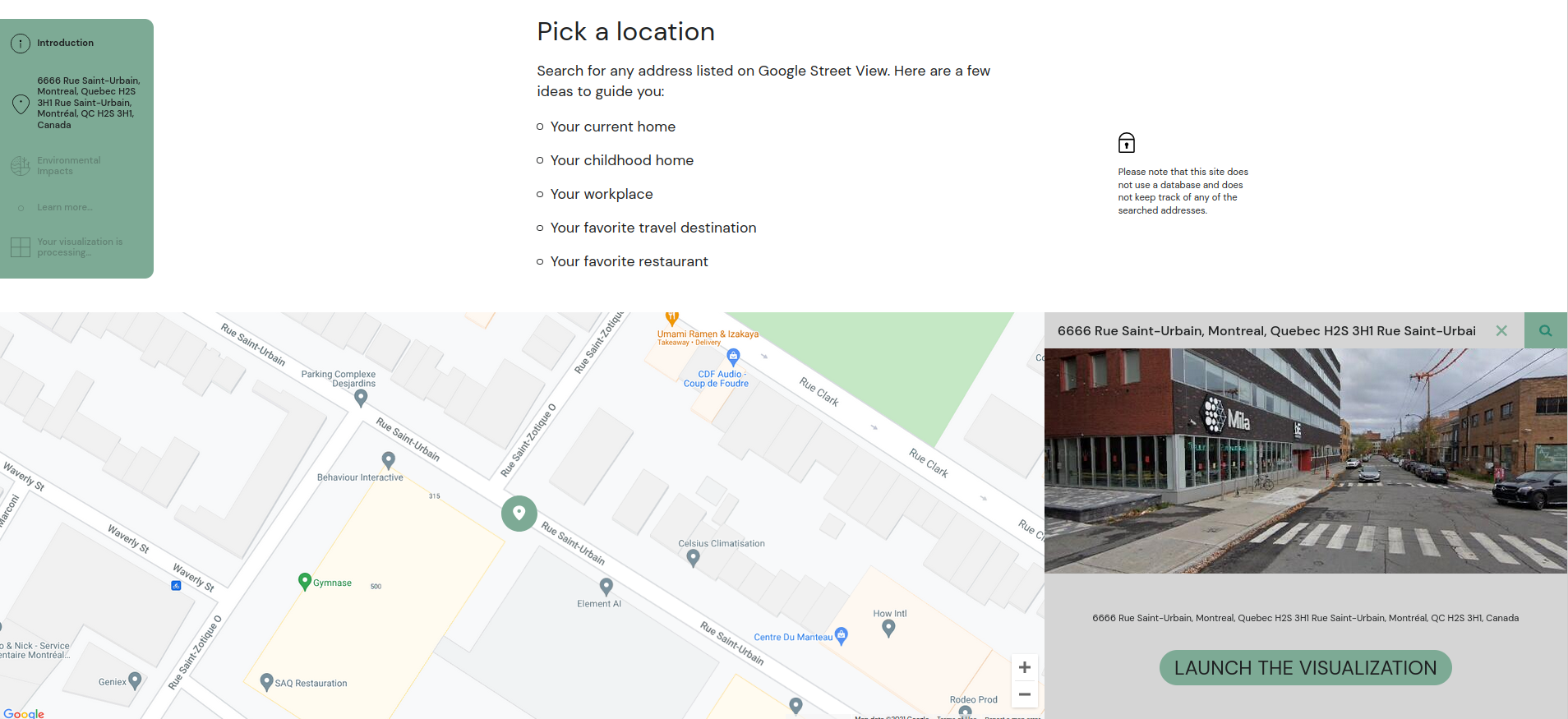 --- count: false ## Ultimate goal of the project ### A website to encourage climate change awareness and action .context[An AI-driven experience based on _empathy_] .center[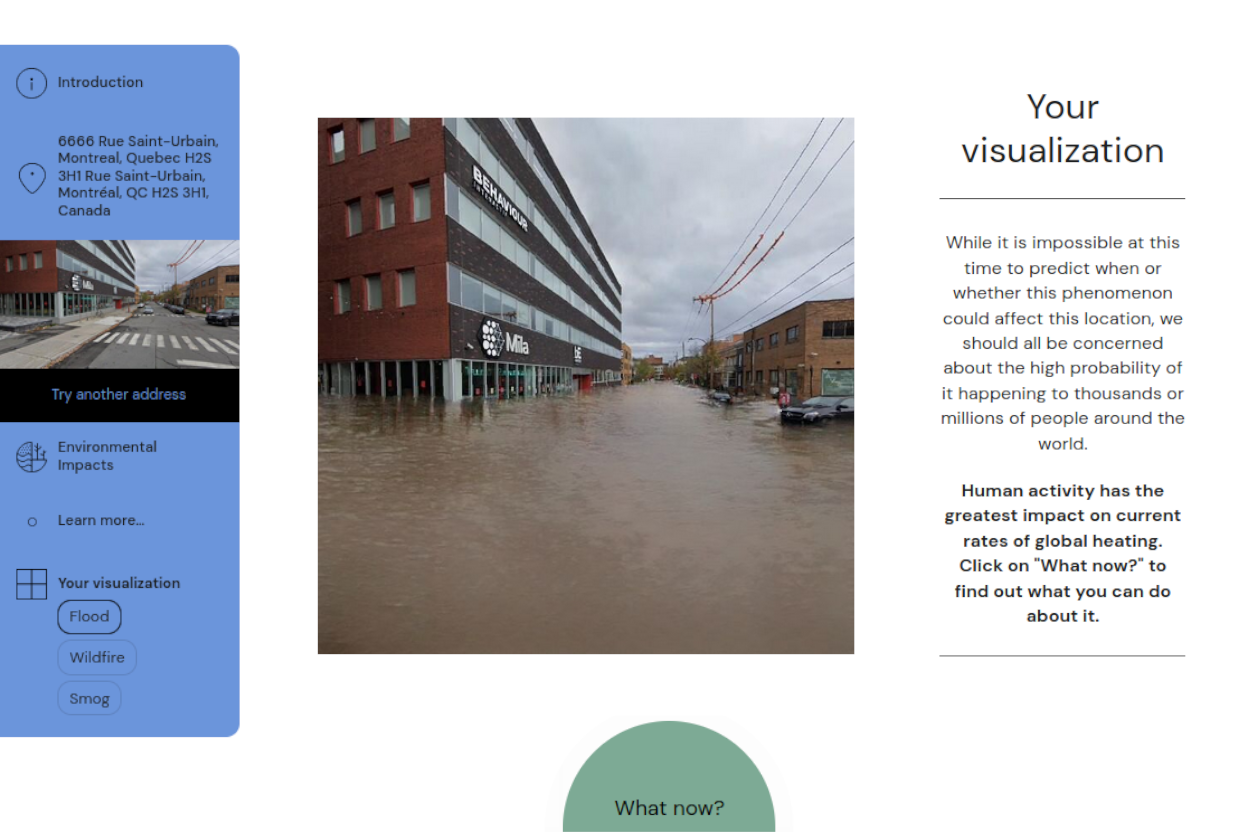] --- ## Methods ### Floods simulation with _ClimateGAN_ .context[Simulating photo-realistic floods is challenging because visual perception is very sensitive to unrealistic water (reflections, physics, geometry, etc.)] -- .left-column[ Key features: * Data from a simulated virtual word to overcome the lack of training data * Two-stage flood generation: _Masker_ + _Painter_ * Domain adaptation to bridge the gap between simulated and real photos * Combination of _depth_ and _semantic segmentation_ to improve water mask predictions * Conditional image generation to _paint_ realistic water on the predicted mask ] .right-column[ 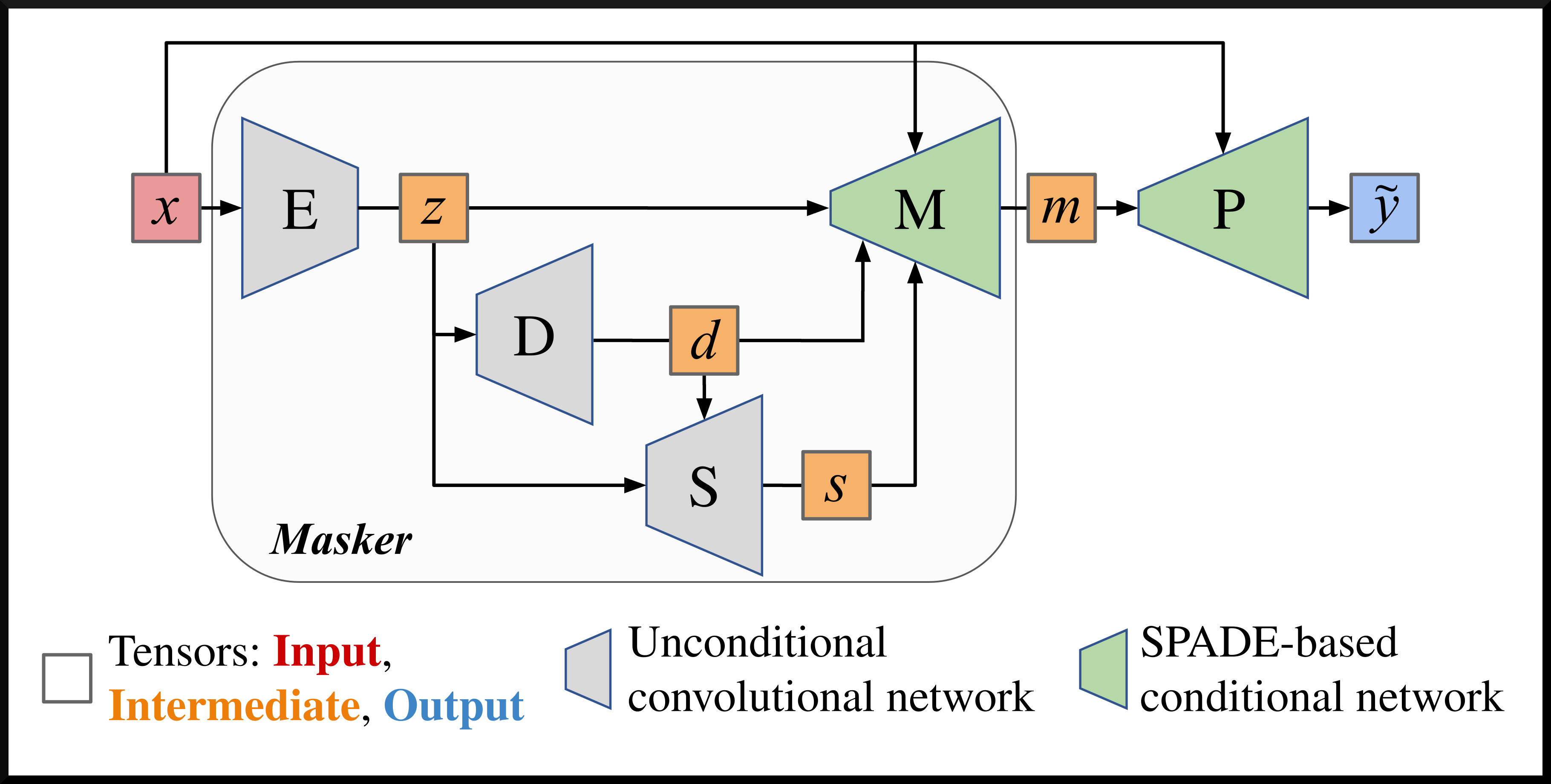 ] --- ## ClimateGAN ### Simulated data .context[We collected 1,200 photos of real floods and 5,500+ _non-flooded_ scenes to train our model. However, _real_ photos lack geometry and segmentation labels.] We simulated a $1.5~km^2$ virtual world with Unity3D and generated 20,000 images that mimic Google Street View. .center[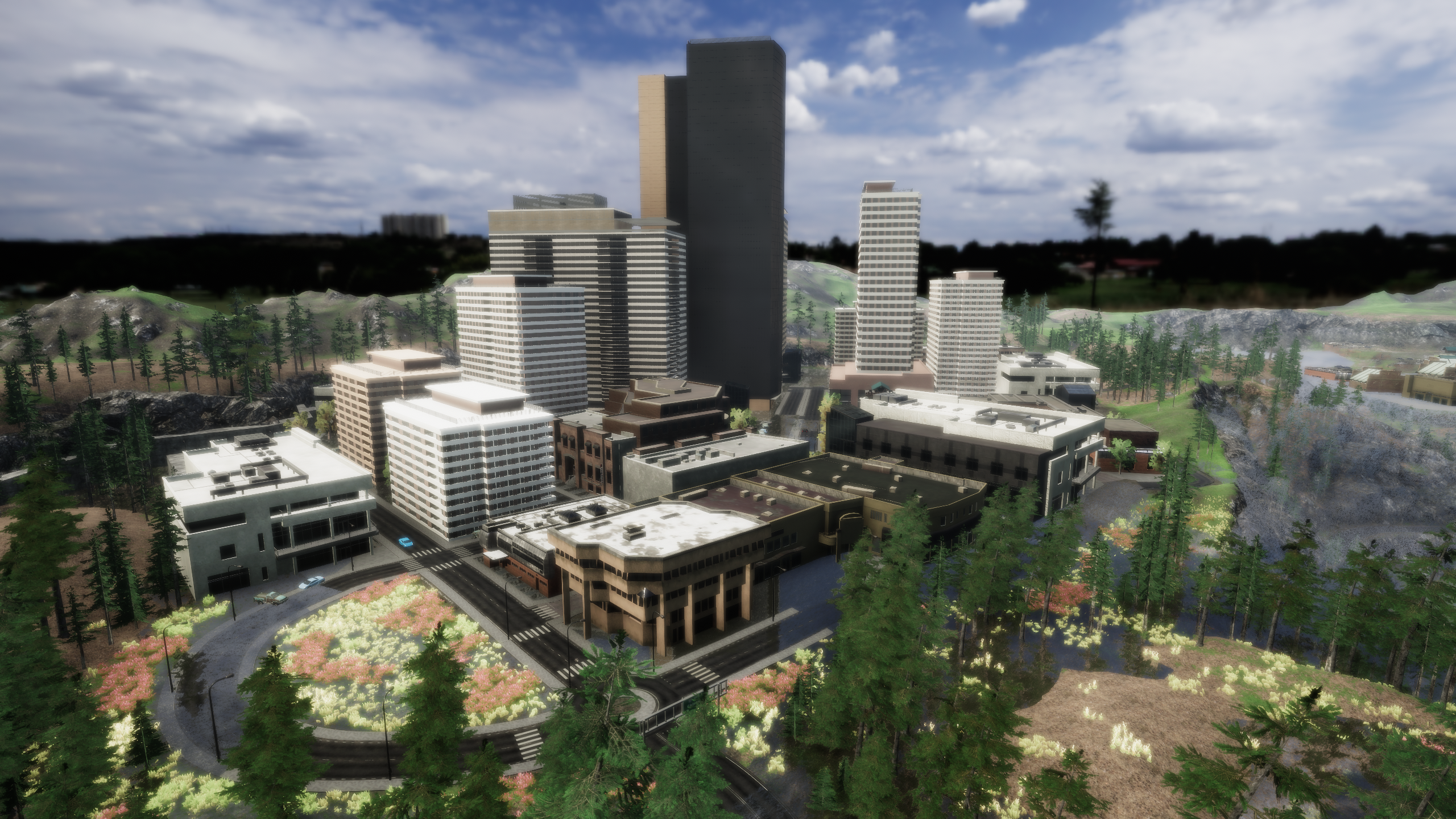] --- count: false ## ClimateGAN ### Simulated data .context[We collected 1,200 photos of real floods and 5,500+ _non-flooded_ scenes to train our model. However, _real_ photos lack geometry and segmentation labels.] We simulated a $1.5~km^2$ virtual world with Unity3D and generated 20,000 images that mimic Google Street View. .center[] --- ## ClimateGAN ### Masker .left-column[ * Trained with _real_ and _simulated_ images * Domain adaptation with ADVENT * Depth decoder * Segmentation decoder * Mask decoder conditioned on depth and segmentation using SPADE * All decoders trained simultaneously (multi-task learning) ] .right-column[  ] --- counter: false ## ClimateGAN ### Masker .left-column[ * Trained with _real_ and _simulated_ images * Domain adaptation with ADVENT * Depth decoder * Segmentation decoder * Mask decoder conditioned on depth and segmentation using SPADE * All decoders trained simultaneously (multi-task learning) ] .right-column[  ] .conclusion[The masker receives an input image and outputs a binary mask of the water location, making intermediate predictions of depth and semantic segmentation.] --- ## ClimateGAN ### Painter .left-column[ * Trained with 1,200 real images of floods * The painter has to generate flooding water conditioned on the context of the image: sky, buildings, etc. * Conditional image generation with GauGAN * Conditioned on the Masked image * SPADE blocks ] .right-column[  ] --- counter: false ## ClimateGAN ### Painter .left-column[ * Trained with 1,200 real images of floods * The painter has to generate flooding water conditioned on the context of the image: sky, buildings, etc. * Conditional image generation with GauGAN * Conditioned on the Masked image * SPADE blocks ] .right-column[ 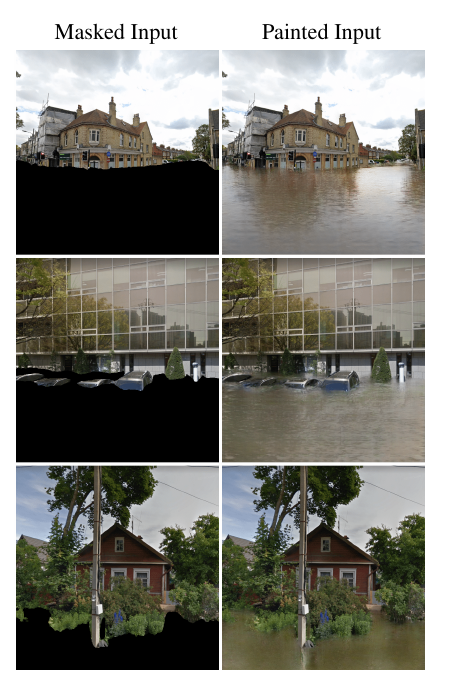 ] .conclusion[The painter receives an input image and a mask prediction and outputs an image of a flood that we combine with the masked input.] --- ## ClimateGAN ### Masker + Painter .center[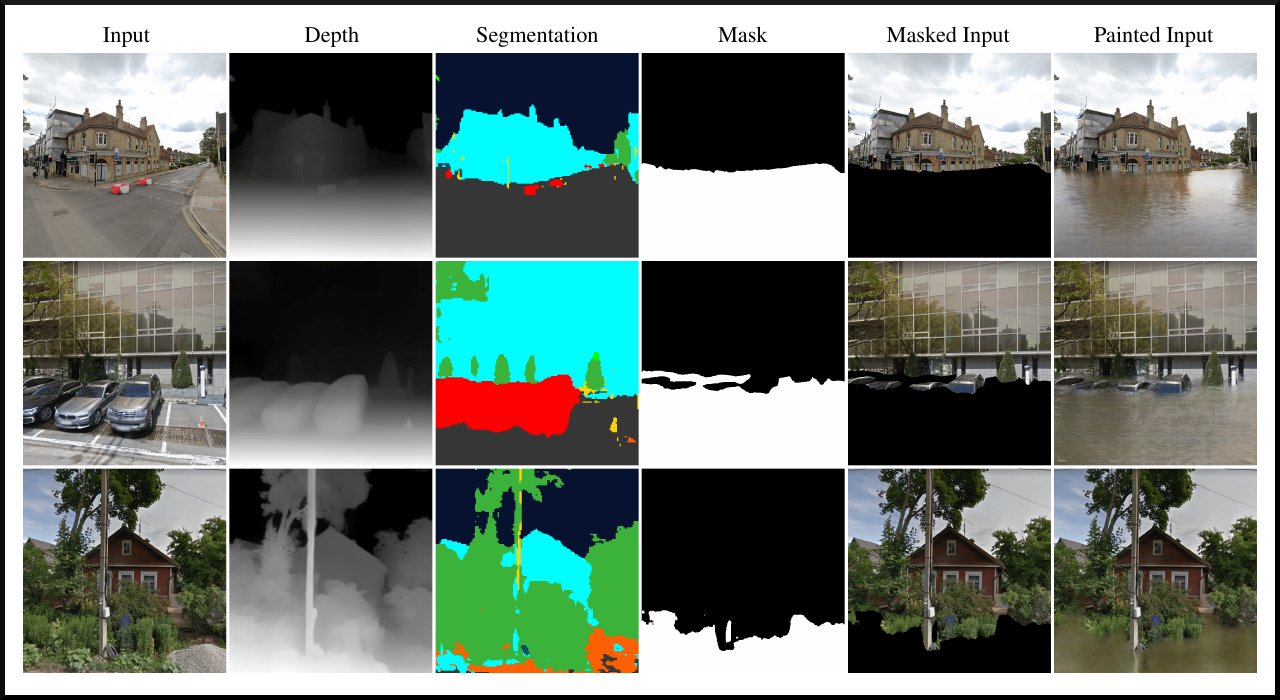] --- ## ClimateGAN ### Comparison with other methods .center[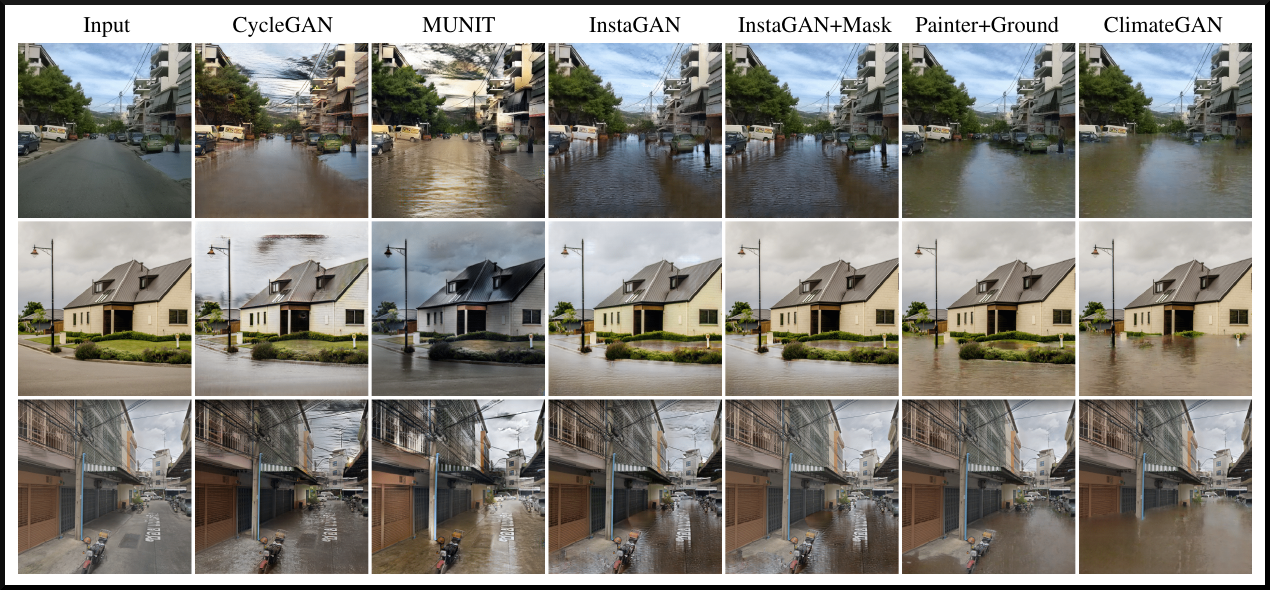] --- ## ClimateGAN ### Human evaluation _Which image looks more like an actual flood?_ .center[] --- ## Visualising the effects of climate change  Coming out soon: * Website for the general public (September) * Scientific article with the description of the methods (July / August) <br><br> .conclusion[We hope that our website contributes to raise awareness and encourage action to fight climate change.] --- name: title class: title, middle count: false ## ML and DS to fight the climate emergency ### Visualising the effects of climate change, .highlight1[material discovery] and downscaling <br> ### .left[Outline] .left[ * [~~Visualising the effects of climate change~~](#vicc) * [.highlight1[Accelerating material discovery]](#materialdiscovery) * [Downscaling Global Climate Models](#downscaling) ] --- name: materialdiscovery ## Accelerating material discovery with machine learning <br><br> .center[] --- ## Accelerating material discovery with machine learning ### Motivation .center[ <figure> <img src="../assets/images/slides/materials/hydrogen_methane_storage.png" alt="Hydrogen and methane storage" style="width: 80%"> <figcaption>.cite[(Lawrence Zitnick et al., 2020)]</figcaption> </figure> ] * Renewable energy can be used to transform water into hydrogen or methane and back to electricity * However, current electrocatalysts are not sufficiently energy-efficient (35 % for round-trip AC to AC) .references[ * Lawrenece Zitnick et al. [An introduction to electrocatalyst design using machine learning for renewable energy storage](https://arxiv.org/abs/2010.09435). arXiv:2010.09435, 2020. ] --- ## Why machine learning? ### Traditional electrocatalyst design .context[Current electrocatalyst are only up to 35 % energy efficient] .right-column-66[.center[]] -- .left-column-33[ A _relaxation_ of propane (C3H8) on a copper (Cu) surface. <br><br> .center[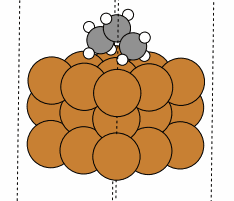] ] --- count: false ## Why machine learning? ### Traditional electrocatalyst design .context[Current electrocatalyst are only up to 35 % energy efficient] .right-column-66[.center[]] .left-column-33[ * Density Functional Theory is used to estimate the energy of a catalyst-molecule structure * DFT scales with $O(n^3)$ with the number of electrons * The calculations for one structure take hours or days * There are combinatorially many possible candidate materials ] --- ## Why machine learning? ### ML world model .context[Physical models are computationally too expensive for fast discovery.] .right-column-66[.center[]] -- .left-column-33[ * Data from physical models can be used to train ML-based approximators * ML models can be used to more rapidly evaluate candidate materials ] -- Can we do better? --- ## Why machine learning? ### RL-based exploratory policy .context[Using ML to only score candidate materials provides only _linear_ gains.] .right-column-66[.center[]] -- .left-column-33[ * We can train ML models to more efficiently search the space of candidate materials * An RL agent could exploit the structure of the search space ] Promising results: [GFlowNet](https://arxiv.org/abs/2106.04399) (Bengio et al., 2021) --- ## Accelerating scientific discovery ### Summary .right-column[.center[]] .left-column[ * World model: graph neural networks (GNN), capable of incorporating invariances and equivariances that preserve physical properties * Exploratory agent: RL-based algorithms capable of learning the structure of the _world_ to propose diverse, high-reward candidates ] .full-width[ .conclusion[These principles have applications in material discovery, drug discovery, causal reasoning, etc. and have the potential of pushing the boundaries of machine learning research.] ] --- name: title class: title, middle count: false ## ML and DS to fight the climate emergency ### Visualising the effects of climate change, material discovery and .highlight1[downscaling] <br> ### .left[Outline] .left[ * [~~Visualising the effects of climate change~~](#vicc) * [~~Accelerating material discovery~~](#materialdiscovery) * [.highlight1[Downscaling Global Climate Models]](#downscaling) ] --- name: downscaling ## Downscaling Global Climate Models with deep learning <br> .center[] .left[.cite[Climate Dynamycs Group, Caltech]] --- ## Why downscaling? .right-column-33[.center[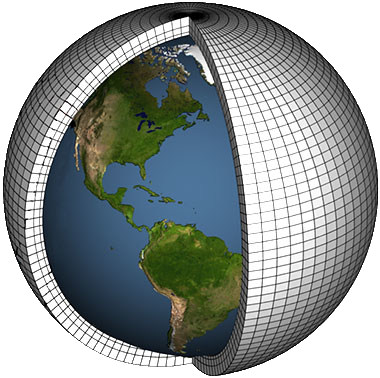]] .left-column-66[ * Enhance spatial resolution of global climate models (> 100 $km^2$) * Enable regional analysis and intervention: * Risk assessement * Sustainability of infrastructure * Understanding effects on ecosystems * Mitigation strategies * Mitigate systematic biases of global climate models * Generate variables not present in climate models ] .full-width[ <br> .conclusion[Global climate models have too coarse resolution to be used in many practical applications] ] --- ## Why machine learning? Two types of downscaling methods: .left-column[ Statistical downscaling: * Interpolation methods * Computationally affordable * Outputs can be highly erroneous ] .right-column[ Dynamical downscaling: * Climate models run at high resolution regionally * Computationally expensive * Prone to propagating biases from global models ] -- .center[ Machine learning promises: * Learn the relevant structure from existing GCM data * Affordable computational costs ] .references[ * Baño-Medina et al. [Configuration and intercomparison of deep learning neural models for statistical downscaling](https://gmd.copernicus.org/articles/13/2109/2020/gmd-13-2109-2020.pdf). Geoscientific Model Development, 2020. * Groenke et al. [ClimAlign: Unsupervised statistical downscaling of climate variables via normalizing flows](https://arxiv.org/abs/2008.04679). arXiv:2008.04679, 2020 ] --- ## Why machine learning? The machine learning communities have developed methods that resemble the problem of climate data downscaling. .center[] --- count: false ## Why machine learning? The machine learning communities have developed methods that resemble the problem of climate data downscaling. .center[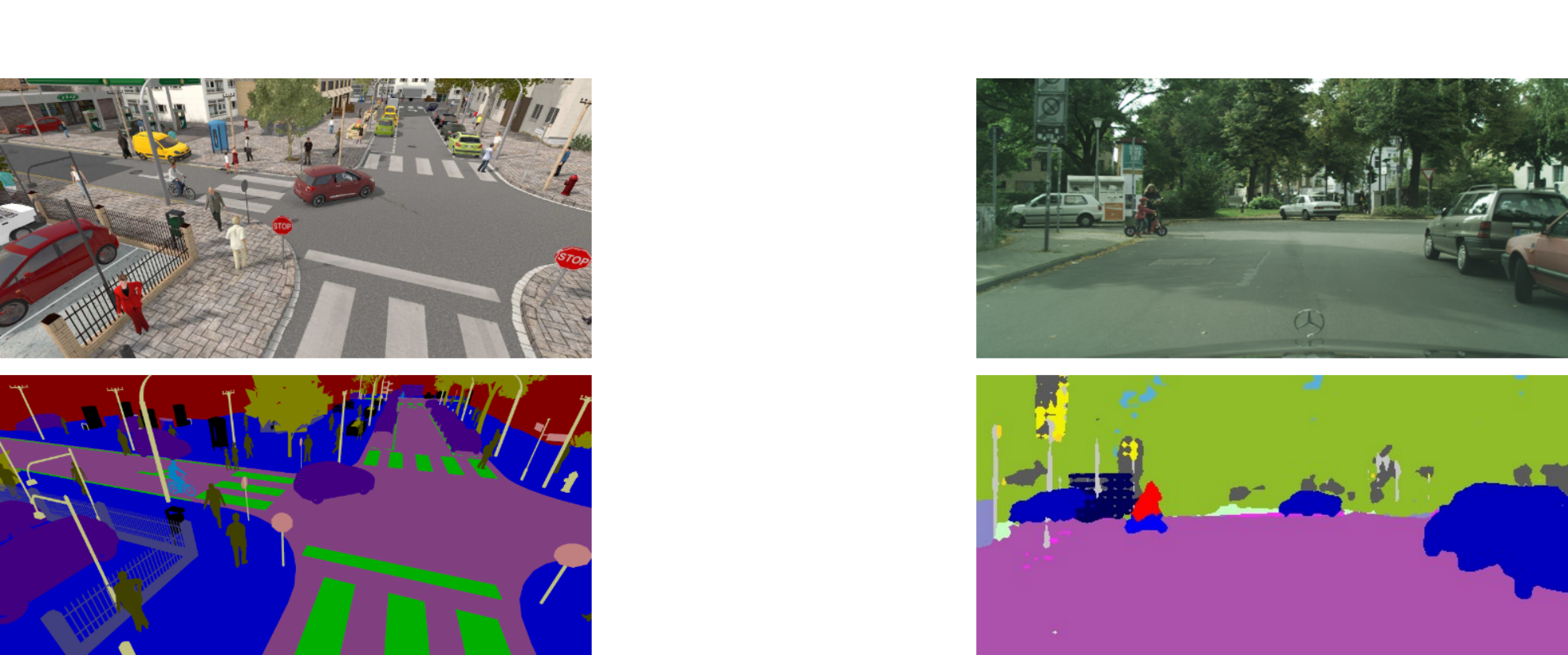] --- name: title class: title, middle ## ML and DS to fight the climate emergency ### Visualising the effects of climate change, material discovery and downscaling <br> ### .left[Outline] .left[ * [~~Visualising the effects of climate change~~](#vicc) * [~~Accelerating material discovery~~](#materialdiscovery) * [Downscaling Global Climate Models](#downscaling) ] --- ## Summary .columns-3-left[ .center[ Photo-realistic generation of flood images to enable empathy <img src="../assets/images/slides/vicc/mila_flood.png" alt="Mila flooded" style="height: 10em"> ] ] .columns-3-center[ .center[ Accelerated material discovery with deep and reinforcement learning <img src="../assets/images/slides/materials/activelearning_agent.png" alt="Active learning" style="height: 10em"> ] ] .columns-3-right[ .center[ Downscaling global climate models with deep learning <img src="../assets/images/slides/downscaling/gcm_sample2.png" alt="Downscaling" style="height: 10em"> ] ] --- name: title class: title, middle count: false ### Merci beaucoup ! Alex Hernández-García (he/il/él) .turquoise[Women in Machine Learning & Data Science · Yaoundé · July 24th 2021] .center[ <a href="https://mila.quebec/"><img src="../assets/images/slides/logos/mila-beige.png" alt="Mila" style="height: 6em"></a> <a href="http://wimlds.org/"><img src="../assets/images/slides/logos/wimlds-logo-only.png" alt="WiMLDS" style="height: 6em"></a> ] .footer[[alexhernandezgarcia.github.io](https://alexhernandezgarcia.github.io/) | [alex.hernandez-garcia@mila.quebec](mailto:alex.hernandez-garcia@mila.quebec) | [@alexhdezgcia](https://twitter.com/alexhdezgcia)] [](https://twitter.com/alexhdezgcia) --- name: title class: title, middle count: false ## ML and DS to fight the climate emergency ### Visualising the effects of climate change, material discovery and downscaling .center[ <img src="../assets/images/slides/vicc/mila_flood.png" alt="Mila flooded" style="height: 10em"> <img src="../assets/images/slides/materials/activelearning_agent.png" alt="Active learning" style="height: 10em"> <img src="../assets/images/slides/downscaling/gcm_sample2.png" alt="Downscaling" style="height: 10em"> ] .footer[[alexhernandezgarcia.github.io](https://alexhernandezgarcia.github.io/) | [alex.hernandez-garcia@mila.quebec](mailto:alex.hernandez-garcia@mila.quebec) | [@alexhdezgcia](https://twitter.com/alexhdezgcia)] [](https://twitter.com/alexhdezgcia)